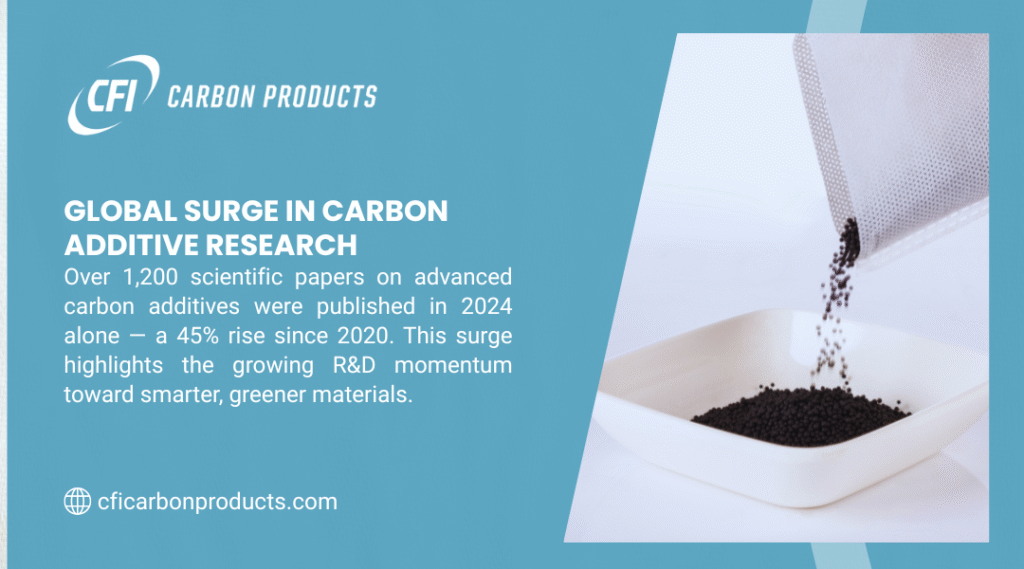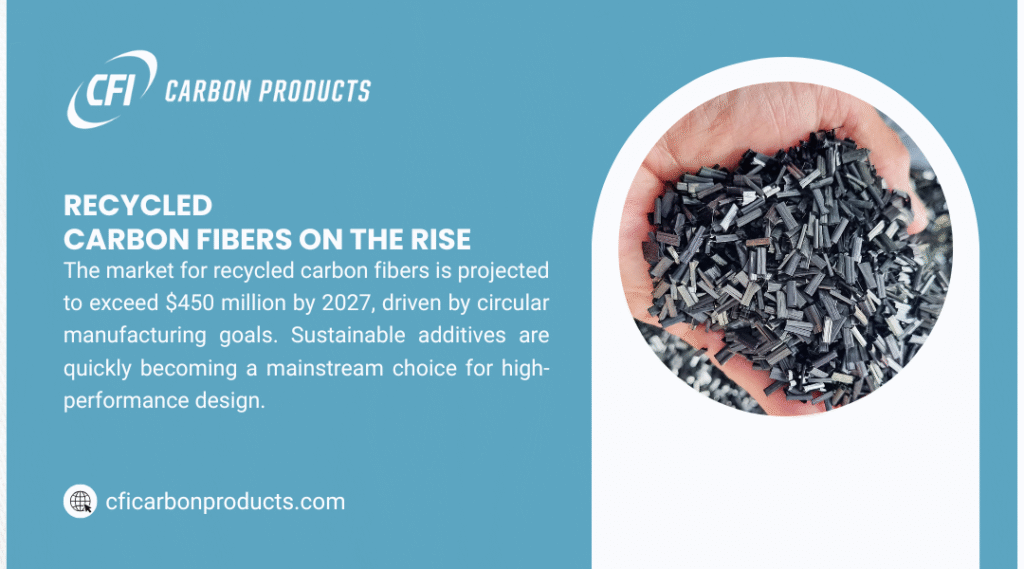The demand for high-performance carbon additives grows daily as manufacturers move away from standard fillers toward specialized compounds. These additives are no longer simple cost extenders; they represent critical functional components that dictate material success in demanding applications like electric vehicles (EVs) and smart electronics. This summary details the core topics this complete guide addresses.
| Topic Focus | Key Takeaway for Manufacturers | Data Point of Note |
| Market Imperative | Selection of high-performance carbon additives is vital for components in the $70+$ billion high-performance composites market. | The overall performance additives market reaches $138 billion in 2025, with plastics a leading segment. |
| Sustainability Metrics | Low-emission carbon additives support stringent environmental goals and reduce a product’s embodied carbon. | Austin Black 325 manufacture emits $80\%$ less carbon than competitors, a critical sustainability advantage. |
| The Density Advantage | Fillers with low specific gravity cut raw material cost and greatly reduce component weight, crucial for automotive applications. | Austin Black 325 has a specific gravity of $1.31$, delivering high volume fill at minimal mass. |
| Material Function | These additives provide superior mechanical reinforcement, thermal stability, and essential electrical function. | Additives improve properties such as stiffness, wear resistance, and heat distortion temperature. |
| The Future of Carbon | The industry is moving toward advanced forms like carbon nanotubes (CNTs) and specialized functional conductive carbon. | Developments focus on battery components to raise energy density and longevity. |
What are High-Performance Carbon Additives?
High-performance carbon additives are sophisticated compounds incorporated into base materials, such as rubber, plastics, silicones, and coatings, to elicit specific, demanding properties. Unlike commodity fillers, these additives target superior mechanical, thermal, or electrical functions crucial for modern product design.
Plastics and other polymers often require help to meet the extreme specifications of today’s industrial applications. Pure polymers might lack the tensile strength, heat resistance, or electrical function that the application demands. High-performance carbon additives solve this problem through several mechanisms:
- Reinforce the polymer matrix, which creates high tensile and flexural strength.
- Raise the material’s heat deflection temperature (HDT) to permit use in hot environments.
- Control the material’s electrical behavior, make it either a conductor or an insulator.
- Offer significant cost advantages by replacing more expensive, high-mass specialty chemicals.
The choice of the correct high-performance carbon additives is a strategic decision. It determines component reliability, dictates processing efficiency, and impacts the product’s long-term environmental footprint. Manufacturers can delve into the fundamental material at what is carbon black.

The Strategic Need for High-Performance Carbon Additives
The current manufacturing landscape requires materials that exceed standard specifications. Component failure is not only costly but also compromises safety in critical applications. High-performance carbon additives provide the necessary margin of safety and the competitive advantage a product needs.
Direct Benefits of Use
| Performance Metric | Contribution of Carbon Additives | Application Example |
| Mechanical Strength | Carbon materials act as stress concentrators, which prevent crack propagation. This greatly raises abrasion resistance and tear strength. | Plastic reinforcement for durable, industrial wear parts. |
| Thermal Stability | High-performance carbon additives stabilize the polymer chain, which prevents heat-related material degradation. | Automotive components near the engine are where high temperature is a constant factor. |
| Electrical Function | The additive creates controlled conductive pathways, which enable applications in electronics and antistatic systems. | Use of conductive carbon in electronics enclosures and static-dissipative equipment. |
| Process Cost Control | Low specific gravity fillers, such as Austin Black 325, allow volume replacement of heavier, expensive resins. | Manufacturers find savings when they review carbon black pricing against the total compound cost. |
| UV Resistance | Fine carbon black particles act as the industry’s premier UV stabilizer additive, which protects the polymer from sun-induced decay. | Outdoor rubber roofing material and infrastructure components. |
The move toward high-performance systems in automotive and electronics drives the performance additives market, which reaches an estimated $138 billion in 2025. The plastic segment alone represents a significant portion of this growth, highlighting the importance of sophisticated plastic additives.
Sustainability and Verified Green Performance
Modern procurement mandates a focus on verifiable sustainability. High-performance carbon additives contribute to environmental goals through both their composition and their functional properties. The material must not only perform but also carry a minimal environmental burden.
Carbon Additives: A Low-Emission Choice
| Environmental Factor | Sustainability Mechanism | CFI Product Data |
| Carbon Footprint | CFI’s proprietary production process for Austin Black 325 results in significantly lower process emissions. | Austin Black 325 manufacture shows a reduction of $80\%$ less carbon emissions versus traditional high-volume competitors. |
| Energy and Weight Reduction | Low specific gravity ($1.31$) means a lighter final product, which requires less energy for transport and operation. | Reduced mass in EV parts contributes directly to higher battery range and lower energy density requirements for the structural shell. |
| Resource Efficiency | The material provides superior function at lower loading, which reduces the total amount of additive a system requires. | Optimization reduces the overall dependency on high-mass plastic filler material. |
| Life Cycle Support | The inert nature of the filler does not complicate end-of-life recycling or reprocessing of the plastic composite. | Supports the long-term goal of the circular economy for various plastic fillers. |
The commitment to eco-friendly rubber alternatives and sustainable high-performance carbon additives is not just a marketing claim; it is a fundamental shift in manufacturing practice. CFI provides the data to back up this claim on the sustainability page.
Carbon Additives: Types and Functional Differentiation
The term high-performance carbon additives spans several distinct material types, each possesses a unique structure and function. The choice among these forms determines the specific property enhancement achieved in the polymer or rubber matrix.
| Carbon Additive Type | Key Structure and Function | Primary Performance Gain |
| Carbon Black | Fine, spherical particles with high surface area act as a primary reinforcing agent and pigment. | UV stability, pigmentation, and mechanical reinforcement in carbon black for rubber. |
| Graphite | Layered, crystalline structure that provides superior electrical function and heat transfer. | Electrically conductive materials, thermal management, and improved friction properties. |
| Austin Black 325 | Low-density, naturally derived carbon-based filler. Offers high volume fill and easy dispersion. | Cost efficiency, significant weight reduction, and good process flow (additives improve flow). |
| Carbon Nanotubes (CNTs) | Tubular nanostructures that provide maximum conductivity and reinforcement at very low loading rates. | Extreme lightweight structural materials and high-spec battery electrode enhancement. |
For a broader look at the types and uses of the material, a manufacturer can consult our resource What is carbon black used for.

Optimize Polymer Traits with Carbon Additives
The function of high-performance carbon additives goes far beyond simple bulk addition. They operate at a molecular level, modify the polymer’s behavior during processing, and throughout the service life of the product. This modification is critical to achieve the desired material profile.
Mechanism of Property Improvement
The introduction of specific carbon structures provides multifunctionality by targeting key polymer characteristics. The table below details the mechanism of this property modification:
| Property Modified | Mechanism of Improvement | Carbon Additive Role & Effect |
| Mechanical Performance | Physical Reinforcement & Stress Redistribution | Well-dispersed carbon particles (e.g., CNTs, highly structured Carbon Black) create a strong, interfacial bond with the polymer matrix. This physical network effectively absorbs and redistributes applied stress, resisting crack initiation and propagation. This is the cornerstone of plastic reinforcement technology. |
| Thermal Management | Heat Dissipation or Insulation | Additive structure (e.g., high-purity Graphite, Graphene) acts as an efficient thermal highway to dissipate heat (improving thermal conductivity), or conversely, as a barrier to block heat flow (improving insulation). This raises the Heat Deflection Temperature (HDT), enabling use in high-heat industrial applications. |
| Electrical Conductivity | Percolation Network Formation | Specialized, high-structure carbon forms (e.g., Conductive Carbon Black, CNTs) create a continuous, low-resistance path; the percolation network, for electrons, making the plastic conductive (ESD/EMI shielding). Conversely, ultra-low loading or specific graphitic forms can act as effective insulators, increasing resistivity for applications like cable sheathing. The question is, is carbon conductive? depends entirely on the additive’s specific form and loading level. |
Key Applications: Where Carbon Additives Rule
Carbon additives are indispensable across high-tech and essential industries, transforming materials from insulators to high-performance functional components.
1. Automotive and Aerospace
Carbon additives, particularly carbon fibers and advanced nanofillers, are crucial for lightweighting and enhancing the structural integrity of vehicles and aircraft, directly impacting fuel efficiency and safety.
| Application Focus | Carbon Additive Role | Benefit Achieved |
| Structural Composites | Carbon Fiber, CNTs for reinforcement | Reduced Weight and increased stiffness |
| ESD/EMI Shielding | Carbon Black, Graphene for conductivity | Protection of sensitive electronic systems |
| Tires and Gaskets | Carbon Black for UV resistance and strength | Extended lifespan and improved durability |
2. Electronics and Energy Storage
The ability of carbon materials to create efficient conductive networks is vital for next-generation electronic devices and powerful energy solutions.
| Application Focus | Carbon Additive Role | Benefit Achieved |
| Lithium-Ion Batteries | Spherical Carbon, CNTs as conductive agents | Enhanced Rate Capability (faster charging/discharging) and cycle life |
| Conductive Plastics | Carbon Black, Graphene Nanoplatelets | Creates Static Dissipative (ESD) materials for device housing |
| Thermal Management | Graphite, Graphene for heat dissipation | Prevents overheating in LEDs and circuit boards |
3. Construction and Infrastructure
In construction, carbon is employed not just for strength but also for smart, functional improvements in materials exposed to harsh environments.
| Application Focus | Carbon Additive Role | Benefit Achieved |
| Cement and Concrete | Carbon Nanofibers for micro-reinforcement | Increased Tensile Strength and crack resistance |
| Smart Coatings | Carbon Nanoparticles for self-sensing | Structural Health Monitoring (SHM) and Self-Healing Capabilities |
| Pipes and Fittings | Carbon Black for UV stabilization | Protection against environmental degradation in outdoor use |
Comparison to Standard Fillers
When a manufacturer selects high-performance carbon additives over commodity fillers like clay or calcium carbonate, the decision is a choice for function over simple cost extension. Commodity fillers primarily cut material costs but often compromise mechanical strength.
| Feature | High-Performance Carbon Additives | Commodity Mineral Fillers | Key Differentiator |
| Weight Reduction | Excellent; low specific gravity options (e.g., Austin Black 325) permit high volume at low mass. | Poor; high-mass inorganic materials add significant weight to the final product. | Carbon black density is superior for weight control. |
| Mechanical Gain | High acts as a true reinforcing agent that significantly raises tensile and flexural strength. | Low to Moderate; often act as inert spacers, which can decrease impact strength. | Superior plastic reinforcement capability. |
| Electrical Function | Versatile; capable of delivering high conductivity or high insulation, depending on grade. | Poor; typically inert dielectric materials. | Control over electrical properties is a unique carbon advantage. |
| UV Protection | Excellent; a proven absorber and blocker of UV radiation. | Poor; requires secondary chemical plastic additives for UV protection. | Best-in-class weather durability. |
The fundamental material difference shows why carbon additives are in a class separate from general plastic filler material. This separation is the basis for premium material pricing and performance. For a full technical list of products and their specifications, manufacturers can visit the resources index.

Future Development in Carbon Additives
The frontier of carbon additive development is marked by a drive toward multifunctionality, sustainability, and integration into “smart” materials. Key developments include:
Multifunctional Hybrid Additives: Moving beyond single-property enhancement, researchers are developing hybrid carbon systems (e.g., CNT-Graphene mixtures) that simultaneously offer superior mechanical, electrical, and thermal properties. This is crucial for creating truly multifunctional composites.
Carbon Additives in Solid-State Batteries (SSBs): Carbon conductive additives are being engineered specifically for solid-state electrolytes to maintain the critical electron pathways. The focus is on using materials like spherical carbon to ensure homogeneous distribution and optimize the electrode/solid-electrolyte interface, which is key to achieving high energy density and safety in next-generation SSBs.
Smart and Responsive Materials: The integration of carbon nanomaterials (like Graphene and CNTs) is enabling the creation of polymers that can sense and respond to stimuli. This includes Piezoresistive Sensors for strain detection (used in smart apparel and infrastructure monitoring) and Self-Healing Coatings that repair damage autonomously, extending product lifespan.
Sustainable and Circular Carbon: The industry is increasing its focus on sustainable sourcing, including the development of Recycled Carbon Fibers (rCF) that offer a lower environmental footprint while maintaining high performance. Efforts are also accelerating to produce high-purity carbon materials using lower-energy, greener chemical processes.
The Austin Black 325 Advantage: A Strategic Choice
Austin Black 325 from CFI Carbon Products represents the pinnacle of sustainable, high-performance carbon additives. Its unique, naturally derived composition delivers a performance profile that meets the twin demands of the market: superior function and cost control.
| Metric | Austin Black 325 Value | Strategic Benefit to the Manufacturer |
| Cost Efficiency | Proven to reduce overall formulation costs in $75\%$ of documented case studies. | Lowers material expenditure without any compromise on final product quality. |
| Weight/Density | Specific gravity of $1.31$, which is significantly lower than many competing carbon blacks. | Achieve weight reduction targets in automotive and aerospace parts immediately. |
| Dispersion Quality | Easy and uniform mixing into the polymer, which minimizes processing time and defects. | Additives improve production throughput, reduce energy consumption, and simplify quality control. |
| Sustainability | Low-emission production profile. | Meet the highest environmental standards and gain a clear competitive edge in green procurement. |
To achieve a true high-performance material, manufacturers must select partners who provide not just a product, but technical expertise. CFI Carbon Products offers this partnership. Our team helps you tailor the loading and process to the specific needs of your application.
For a deeper look at real-world specifications, technical performance data, and case studies showing how Austin Black 325 can enhance polymer formulations, explore the full Austin Black 325 product page here.
Final Key Takeaways
| Aspect | Key Insight | Implication for Industry |
| Core Value | Carbon additives are fundamental to transforming commodity polymers into high-performance, functional materials. | Necessary for next-generation lightweighting, electrification, and smart systems. |
| Nanotechnology | CNTs and Graphene offer unprecedented property enhancements at minimal loading levels. | Enables thinner, lighter products (e.g., flexible screens, ultra-light aircraft parts). |
| Future Direction | Research is centered on multifunctionality, self-sensing, and sustainability (e.g., recycled carbon and SSB integration). | Guarantees continued innovation and market disruption across aerospace, energy, and electronics. |
Conclusion: The Unstoppable Force of Carbon
Carbon additives are not merely fillers; they are catalysts for material evolution. From delivering the structural fortitude needed for space travel to providing the electronic pathways essential for the electric revolution, carbon’s versatility and performance profile are unmatched. The continuous innovation in forms like Graphene and Carbon Nanotubes ensures that polymers will remain at the forefront of engineering breakthroughs, driving forward sectors that demand superior strength, thermal management, and conductivity.
The future of advanced materials is intrinsically linked to the mastery of carbon.
Ready to Innovate? Don’t let your material performance lag behind. Explore how tailored carbon additive solutions can unlock the next level of strength, conductivity, and intelligence in your polymer products. Contact our materials science team today to start designing your next-generation composite.

